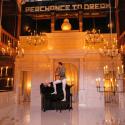It was a bold choice by director Blanche McIntyre to stage Ben Jonson's seldom performed, sprawling slice-of-life play in the bijou Sam Wanamaker Playhouse rather than Shakespeare's Globe's main stage – even if she has pared down both the script and what seems like a cast of thousands for her modern-dress production.
The play was first staged in 1614 in the Hope Theatre, a venue for both plays and bear-baiting. It describes various characters who attend Bartholomew Fair (held in what is today's Smithfield area of London), which began as a cloth fair in 1133 and grew to international importance.
Aside from the business transacted, the fair – a huge event on the social calendar – featured puppet shows, prize fighters, musicians, circus acts and even wild animals, and attracted people across all social strata, including criminals. By the time it was shut down by the authorities in 1855, it had become a byword for debauchery and public disorder.
 Jonson creates a detailed and vivid picture of London life and comments wryly on the social conventions and religious hypocrisies of Jacobean England.
Jonson creates a detailed and vivid picture of London life and comments wryly on the social conventions and religious hypocrisies of Jacobean England.
One can only imagine how visceral (in every sense) this play must have felt to spectators at the Hope back in the 17th century; Jonson described the theatre as being “as dirty as Smithfield and stinking every whit”, and the play has much raucous good humour. Even allowing for 21st-century rules and regulations and the lack of smell-surround, McIntyre's production in Ti Green's design feels rather sanitised, despite a vomit scene and some noisy shagging off-stage.
The characters, however, are all as unsympathetic in their modern-day equivalents as they were in 1614. The complicated story, which includes gullings, disguised characters and overlapping storylines, is described by the pompous, by-the-book justice of the peace Adam Overdo (Dickon Tyrell), who goes undercover at the Fair to seek out what he calls “enormities”.
We see Littlewit, a writer (Joshua Lacey), and his friend Quarlous do a line of cocaine as they plan their day at the fair. The play's dark undercurrent is hinted at here as Jude Owusu's Quarlous (Pictured above) roughly seizes Littlewit's pregnant wife, Win (Boadicea Ricketts), for a passionate kiss that should but doesn't faze her husband.
In a plotline that doesn't make any sense in a modern-dress production, Win wants to attend the fair, but has to make an excuse to her religious mother Dame Purecraft (Anita Reynolds), who is in thrall to richly vowelled Southern preacher Zeal-of-the-Land Busy (Jenna Augen), a character originally written to guy 17th-century Puritans. The couple make up a story that Win has pregnancy cravings for pork, which the fair was famed for.
Elsewhere, guardians, rich widows and poor charges make their plans to attend the fair, and a plotline involving a stolen marriage certificate unfolds.The stories all interwine at the fair, and in the denouement the strands are neatly tied and the play's moral purpose laid out.
The cast (who double or triple up on roles) are uniformly terrific as they pull off lightening-quick changes and nicely delineate multiple characters. Special mention goes to Forbes Masson, who gets great comedy mileage out of the three characters he plays, particularly his lay-dee costermonger selling pears.
The pace quickens in the second half after a first act that rather drags despite the play's chaotic nature. Overall it doesn’t quite fulfil its promise.
- Bartholomew Fair at Shakespeare's Globe until 12 October
- Read more theatre reviews on theartsdesk














Add comment